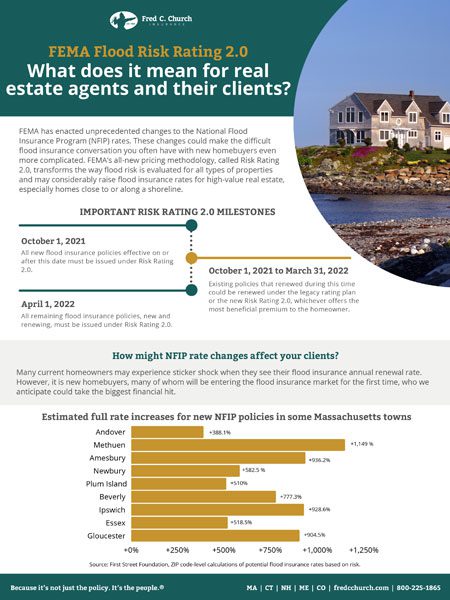The Federal Emergency Management Agency (FEMA) began phasing in its new flood insurance pricing system, Risk Rating 2.0, starting October 1, 2021, so it’s possible real estate professionals are already fielding questions from homebuyers and property owners who want to understand how this new rating system might impact them and their coastal homes or other properties that are susceptible to a water source overflow.
As you may know, FEMA’s old rating system priced flood insurance based on a home’s flood zone, while this new methodology looks at each individual home separately and rates it based on numerous unique factors, such as elevation, distance to a water source, and cost to rebuild. In some cases, this means homeowners could see their rates decrease. However, this is probably not the case for people who own or are looking to buy high-value real estate, especially if their properties are close to or along the shoreline. Instead, the rating changes likely mean that these homeowners and buyers will be faced with flood insurance premiums that are significantly higher than anything you or they have ever seen before.
Currently, FEMA’s rate changes only apply to newly purchased flood insurance policies, but after April 1, 2022, homeowners with existing flood insurance policies through FEMA will be subject to this new rating standard upon renewal.
 If you thought flood insurance was a difficult discussion to have with your clientele before, these rate changes are potentially going to make it even more complex. As your local flood insurance professional, Fred C. Church wants to be here to support real estate agents with information and insights that can be shared with your clients and colleagues.
If you thought flood insurance was a difficult discussion to have with your clientele before, these rate changes are potentially going to make it even more complex. As your local flood insurance professional, Fred C. Church wants to be here to support real estate agents with information and insights that can be shared with your clients and colleagues.
The following downloadable infographic may help you and your clients navigate this new rate reality. It details upcoming milestones for this historic change and illustrates how FEMA’s rate changes could impact flood insurance premiums across numerous Massachusetts towns. As you will see, depending on the location of a residence, flood insurance rate increases could be significant, ranging from 400% to as high as 1,000%. Plus, we outline the action steps you can take to assist your clients to make well-informed—and potentially cost-saving—decisions about their flood insurance program.
If you currently have a flood insurance policy through FEMA or plan to purchase a new flood insurance policy in the future, it’s critical to have a conversation with a trusted professional, like Fred C. Church, about how these new rate changes may affect your premium. We can help you assess the potential impact of Risk Rating 2.0 on your renewal rate or new policy premium and identify your flood insurance options. Also, as new information becomes available, we will be posting it to our blog, Facebook page, and LinkedIn, so keep checking back with us for updates.



